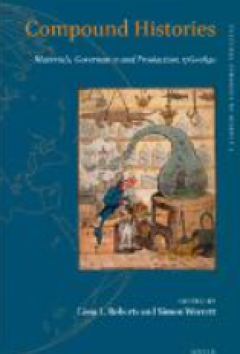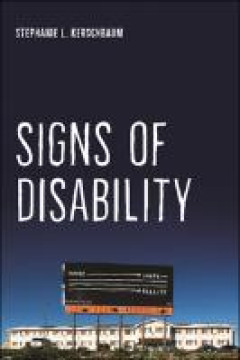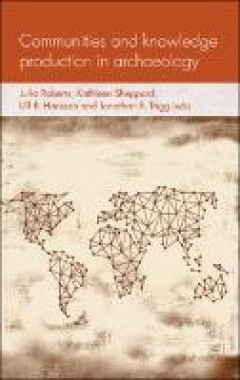Ditapis dengan
E-book Circulation and Control : Artistic Culture and Intellectual Property i…
The nineteenth century witnessed a series of revolutions in the production, circulation, and reproduction of images. Thanks to changes in printing and imaging technology and shifts in the practices of artists, publishers, and photographers, images became more readily available, in a wider range of media than ever before. Working in the new field of lithography,…
- Edisi
- -
- ISBN/ISSN
- 9781800641488
- Deskripsi Fisik
- 545 hlm
- Judul Seri
- -
- No. Panggil
- 346.04 ALE c

E-book Compound Histories : Materials, Governance and Production, 1760 1840
Power, transformation, promise, subjugation: terms that might easily be invoked to describe the decades between 1760 and 1840. Together they point toward the multi-faceted developments through which Europe took on its modern character and dominant position in the world – what this volume refers to as ‘compound histories’. Simultaneously …
- Edisi
- -
- ISBN/ISSN
- 9789004325562
- Deskripsi Fisik
- 402 hlm
- Judul Seri
- -
- No. Panggil
- 902 WER c
E-book Jamaica Making : The Theresa Roberts Art Collection
his exhibition at the historic Victoria Gallery and Museum, Liverpool, comprises almost entirely of art works in the collection of Theresa Roberts, who is founder and owner of the Jamaica Patty Co. restaurant, based in Covent Garden, London.Theresa Roberts was born in Jamaica to parents who emigrated to the United Kingdom as part of the ‘Windrush Generation’: those who were invited by Briti…
- Edisi
- -
- ISBN/ISSN
- 9781800855472
- Deskripsi Fisik
- 96 hlm
- Judul Seri
- -
- No. Panggil
- 708 ROB j

E-book Signs of Disability
How can we learn to notice the signs of disability? We see indications of disability everywhere: yellow diamond-shaped “deaf person in area” road signs, the telltale shapes of hearing aids, or white-tipped canes sweeping across footpaths. But even though the signs are ubiquitous, Stephanie L. Kerschbaum argues that disability may still not be perceived due to a process she terms “dis-atte…
- Edisi
- -
- ISBN/ISSN
- 9781479811175
- Deskripsi Fisik
- 247 halaman
- Judul Seri
- -
- No. Panggil
- 362.2 KER s

E-Book Communities and Knowledge Production in Archaeology
The dynamic processes of knowledge production in archaeology and elsewhere in the humanities and social sciences are increasingly viewed as the collaborative effort of groups, clusters and communities of researchers rather than the isolated work of so-called ‘instrumental’ actors. Shifting focus from the individual scholar to the wider social contexts of her work and the dynamic creative pr…
- Edisi
- -
- ISBN/ISSN
- 9781526134561
- Deskripsi Fisik
- 269 halaman
- Judul Seri
- -
- No. Panggil
- 930.1 ROB c
E-book The Early History of Rome
Whether the task I have undertaken of writing a complete history of the Roman people from the very commencement of its existence will reward me for the labour spent on it, I neither know for certain, nor if I did know would I venture to say. For I see that this is an old-established and a common practice, each fresh writer being invariably persuaded that he will either attain greater certainty …
- Edisi
- -
- ISBN/ISSN
- -
- Deskripsi Fisik
- 1881 hlm
- Judul Seri
- -
- No. Panggil
- 937 LIV t
E-book Buddhist Statecraft in East Asia
Perhaps the best way to approach this volume on Buddhist statecraft is with the following observation in mind: the proper functioning of the state is a Buddhist concern. Throughout the history of the tradition, Buddhist have engaged questions of statecraft in their creation and propagation of texts, doctrines, rituals, institutions, and visual cultures. Political actors have, in turn, employed …
- Edisi
- -
- ISBN/ISSN
- 9789004510227
- Deskripsi Fisik
- 202 hlm
- Judul Seri
- -
- No. Panggil
- 294.3 BAL b
E-book Medicine – Religion – Spirituality : Global Perspectives on Tradit…
In the history of religions, tasks such as curing bodily ailments, treating the sick, and dealing with dying were often assigned to religious experts. Con-cepts such as the body, illness, and health were anchored in the world views and practices of the respective religious traditions. As Pamela Klassen (2016: 401) writes: “Medical knowledge and techniques have often emerged di-rectly…
- Edisi
- -
- ISBN/ISSN
- 9783839445822
- Deskripsi Fisik
- 275 hlm
- Judul Seri
- -
- No. Panggil
- 615.5 BRU m
E-book Forests and Food : Addressing Hunger and Nutrition Across Sustainable …
As population estimates for 2050 reach over 9 billion, issues of food security and nutrition have been dominating academic and policy debates. A total of 805 million people are undernourished worldwide and malnutrition affects nearly every country on the planet. Despite impressive productivity increases, there is growing evidence that conventional agricultural strategies fall short of eliminati…
- Edisi
- -
- ISBN/ISSN
- 9781783741953
- Deskripsi Fisik
- 290 hlm
- Judul Seri
- -
- No. Panggil
- 338.1 VIR f
E-book The Spiritual Laws
I have always asked myself many questions, very profound questions. The kind of questions that are called existential questions. I have always wanted to know the reason for my life, the reason for all of our lives. Who am I? Why do I exist? Why do others exist? What are we doing here? Have we come here for anything in particular? Why are we born, why do we die? Where do we come from and where a…
- Edisi
- -
- ISBN/ISSN
- -
- Deskripsi Fisik
- 243 hlm
- Judul Seri
- -
- No. Panggil
- 230 GUI t
 Karya Umum
Karya Umum  Filsafat
Filsafat  Agama
Agama  Ilmu-ilmu Sosial
Ilmu-ilmu Sosial  Bahasa
Bahasa  Ilmu-ilmu Murni
Ilmu-ilmu Murni  Ilmu-ilmu Terapan
Ilmu-ilmu Terapan  Kesenian, Hiburan, dan Olahraga
Kesenian, Hiburan, dan Olahraga  Kesusastraan
Kesusastraan  Geografi dan Sejarah
Geografi dan Sejarah